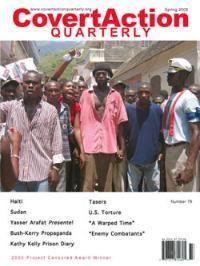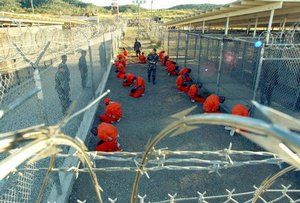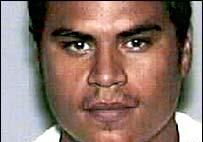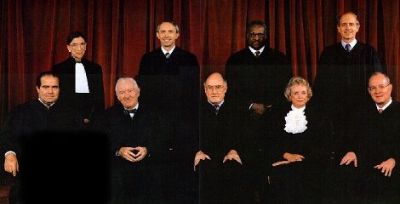
 Covert Action Quarterly Covert Action Quarterly
Spring 2005, Number 78
"If my thought dreams could be seen,
they'd probably put my head in a guillotine."
-Bob Dylan, It's Alright Ma (I'm Only Bleeding)
____________________________________________
Both the corporate media and the pundits of the left claim to see a "major victory" for the "rule of law" in the June 28, 2004 Supreme Court rulings on Guantánamo and "enemy combatants."
But the fundamental aspect of these decisions is that they have enshrined the concept of enemy combatants into our legal system.
From now on, anybody deemed an enemy combatant -- citizen and non-citizen alike -- can be imprisoned and stripped of their constitutional “due process” rights, including the presumption of innocence and the right to a jury trial. Indefinite detention remains an option. The military will be running the show, not the courts.
A few more victories like this, and we will all be eating prison gruel.
David Rivkin, a former legal counsel in the administrations of both Ronald Reagan and George Bush the First, boldly claimed the win for the dark side. “The Supreme Court held that the government is entitled to hold even American citizens as enemy combatants and does not have to treat them as criminal suspects. And that is a huge victory for the government.” (1)
[Former] Attorney General John Ashcroft expressed the concept both sardonically and succinctly, declaring that, in light of the Supreme Court rulings, “certain terrorists have more rights.” (2)
_____________________________________________________________________________
Copyright © 2005 Covert Action Publications, Inc.
Article reproduced here by permission from the publishers.
Submitted to publishers on October 26, 2004.
I have made some minor revisions from the published version.
Contents:
· Anti-Immigrant Hysteria, Domestic Terrorists and Enemy Combatants
· Guantánamo
· Jose Padilla and Yaser Esam Hamdi
· "Major Victory"
· Padilla Ruling: Back to Square One
· Hamdi Ruling: Freedom is Slavery
· Hamdi Ruling: Thomas and the Odd Couple
· Hamdi Ruling: The Swing Votes
· Hamdi's Exile
· Guantánamo Ruling
· The Pentagon's Game Plan
· Military Tribunals
· The Gates to Guantánamo
· Enter Congress?
· The Road Ahead
_____________________________________________________________________________
 ANTI-IMMIGRANT HYSTERIA, DOMESTIC TERRORISTS and ENEMY COMBATANTS ANTI-IMMIGRANT HYSTERIA, DOMESTIC TERRORISTS and ENEMY COMBATANTS
In the immediate aftermath of 9/11, immigrants from Arab and Muslim countries were subjected to a series of federal roundups. Hundreds, if not thousands, were jailed without charges, held incommunicado for unknown periods of time in unknown places. Many of those rounded-up were later deported. There is still no complete and accurate record of these detainees. Thousands more were targeted for “voluntary” interviews and investigations. Many thousands more were subjected to a “special registration” campaign that produced yet more arrests and deportations. FBI director Robert Mueller set “specific numerical goals” for “terrorism investigations,” based on the number of mosques in given communities (3) -- this from a representative of the same political trend that opposes affirmative action. There was open talk of the need for torture of terrorism suspects.
Congress, for its part, rushed through the passage of the Patriot Act. This act, among its many transgressions on the Constitution and the Bill of Rights, included the creation of the new crime of “domestic terrorism.”
The Patriot Act defines a domestic terrorist as someone who commits “acts dangerous to human life that are a violation of the criminal laws... [and] that appear to be intended... to influence the policy of a government by intimidation or coercion.” (4) Many have argued that this broad definition would make terrorists even of Martin Luther King and Rosa Parks. After all, civil disobedience often provokes a response that is “dangerous to human life,” nearly always involves violating the law, and is certainly intended “to influence the policy of a government.” Of course, “intimidation or coercion” are in the eye of the beholder.
As yet, no individual has actually been prosecuted as a domestic terrorist under the Patriot Act. But the creation of the new category of “domestic terrorist,” propagated by the media far and wide, coupled with the ongoing anti-immigrant hysteria, helped lay the ideological groundwork for yet another invented category of criminality, the “enemy combatant.”
The concept of enemy combatants did not emerge from any legislation. It sprung instead from the seeds of war sown in the fields of Afghanistan. By the time the U.S.-made Taliban was driven out of the cities of that war-torn nation, the U.S. found itself holding many hundreds of prisoners. In one of those quaint wars from the 20th century, these prisoners would have been sent to camps for prisoners-of-war. They would have been given the minimal protections of the Geneva Conventions, at least in theory, including the right not to be forcefully interrogated.
But, today, the U.S. is the world’s one-and-only superpower. There is no more Soviet Union. China is, more or less, an ally. France and Germany can do little more than bluster and complain. The government of Britain is a mere lapdog. Most of the rest of the world’s nations are fighting simply to hold their own, or have been reduced to beggar status.
Geneva Conventions? Who is going to enforce them? In this day and age, the masters of war in Washington don’t care one whit about such things.
 Thus, those rounded up during the initial phase of the war in Afghanistan were viewed, not as prisoners-of-war, but as mere assets for CIA and military intelligence forces. Thus, those rounded up during the initial phase of the war in Afghanistan were viewed, not as prisoners-of-war, but as mere assets for CIA and military intelligence forces.
One of the first graphic examples of the status of the Afghan war prisoners was a video of John Walker Lindh, the “Marin Taliban” -- the young, white American Muslim convert from wealthy Marin County, just north of San Francisco, who was captured by U.S.-allied forces in Afghanistan -- being brutally interrogated by U.S. intelligence agents. This video was taken shortly before a prisoner uprising that resulted in the deaths of over 200 prisoners, and at least one CIA operative.
Then came the pictures of Lindh, naked, tied up and crammed into a shipping container, prior to his interrogation. This was three years before the revelations about the torture of prisoners in Abu Ghraib, in yet another imperial war of the early 21st century.
GUANTANAMO
Before long, the prisoners rounded up in Afghanistan were being sent thousands of miles away to Guantánamo Bay, a U.S. military base in Cuba illegally occupied for over a century. The world was presented with more graphic images of prisoners, hog-tied and blindfolded, sent off to open-air cages, treated little better than animals in the zoo.
 Many thousands more have subsequently been snatched from over 100 countries, and sent to secret detention facilities around the world. As President George W. Bush proudly declared in his February 4, 2003 State of the Union address, “More than 3,000 suspected terrorists have been arrested in many countries. Many others have met a different fate.” (5) The existence of a whole system of secret military detention facilities around the world has been best documented in a recent report by Human Rights First. (6) Most of these prisoners haven’t even been touched by the legal struggle over enemy combatants, because they have little or no contact with their families or friends, much less lawyers and courts. They have truly become the “disappeared.” Many thousands more have subsequently been snatched from over 100 countries, and sent to secret detention facilities around the world. As President George W. Bush proudly declared in his February 4, 2003 State of the Union address, “More than 3,000 suspected terrorists have been arrested in many countries. Many others have met a different fate.” (5) The existence of a whole system of secret military detention facilities around the world has been best documented in a recent report by Human Rights First. (6) Most of these prisoners haven’t even been touched by the legal struggle over enemy combatants, because they have little or no contact with their families or friends, much less lawyers and courts. They have truly become the “disappeared.”
In Guantánamo, it was readily apparent to the whole world that the Geneva Conventions were being flagrantly violated. As protests mounted about the incarceration and treatment of the Guantánamo prisoners, it became necessary for the U.S. to develop some excuse for its lawlessness. Thus the concept of enemy combatants.
 For sure, there had been individuals incarcerated in previous U.S. wars, and afforded less than due process. The pundits supporting the barbarity of Guantánamo have been quick to cite any example they could. For those with some historical memory, the example of the Japanese interned during World War II comes readily to mind, although most of the Bush regime’s apologists have stayed away from any discussion of that disgraceful case-in-point. For sure, there had been individuals incarcerated in previous U.S. wars, and afforded less than due process. The pundits supporting the barbarity of Guantánamo have been quick to cite any example they could. For those with some historical memory, the example of the Japanese interned during World War II comes readily to mind, although most of the Bush regime’s apologists have stayed away from any discussion of that disgraceful case-in-point.
But, historical examples be what they may, the category of enemy combatants was brand new. You can’t find this term in any law book, not even in the Patriot Act. But the corporate media, glad to make one of its many contributions to the "war on terror," collaborated with the Bush regime to make up and insert this new category into the political discourse, much like Winston Smith in George Orwell’s 1984 creating history from his desk at the Ministry of Truth.
The Bush regime’s new concept of enemy combatants was breathtaking. As it evolved, it gradually became clear that Bush was claiming the authority to unilaterally declare anyone, anywhere in the world, to be an enemy combatant, and consequently strip them of all rights afforded them by the constitution, by international law, or by any law whatsoever. No assertion of authority could have been more absolute.
JOSE PADILLA and YASER ESAM HAMDI
Still, given the way things work in the U.S., the legal black hole in Guantánamo caused barely a ripple in the body politic. Those disappeared in plain sight in Cuba are, after all, foreigners. U.S. politics is so fundamentally rooted in racism, white supremacy and national chauvinism that our military masters could probably have loaded that island sanctuary down with enemy combatants until it sank, with little serious political consequences. Various civil-libertarian legal organizations filed lawsuits about Guantánamo, but were off-handedly thrown out of court with that age-old excuse of bureaucrats everywhere, “lack of jurisdiction.”
The contrast with the handling of Lindh’s case, the white guy from Marin, couldn’t have been more stark. He was thrown into the slammer, but the keys weren’t thrown away. He got a lawyer (and a good one, at that), and was heading towards an honest-to-goodness trial before he cut a deal.
In July, 2002, Lindh accepted a plea bargain that included a provision that, if he ever engaged in “terrorist” activity again, he would be treated as an enemy combatant, and thus deprived of his normal “due process” constitutional rights. This may have been a good deal for Lindh, but it set a very dangerous precedent for future defendants, especially those not so well sheltered by affluent parents and high-powered attorneys. (7)
And then along came Yaser Esam Hamdi.
 Hamdi shook up the paradigm. No white guy he. But, born in Louisiana the same year that Ronald Reagan was elected President, he was a U.S. citizen, despite the fact that his family later moved to Saudi Arabia. At some point he went off to Afghanistan, according to his father, to do relief work. He was eventually seized by the warlords of the Northern Alliance. The warlords turned him over to the U.S. military. The U.S. imprisoned him for a while in Afghanistan, then sent him to Guantánamo. Hamdi shook up the paradigm. No white guy he. But, born in Louisiana the same year that Ronald Reagan was elected President, he was a U.S. citizen, despite the fact that his family later moved to Saudi Arabia. At some point he went off to Afghanistan, according to his father, to do relief work. He was eventually seized by the warlords of the Northern Alliance. The warlords turned him over to the U.S. military. The U.S. imprisoned him for a while in Afghanistan, then sent him to Guantánamo.
Later, learning that Hamdi was a U.S. citizen, they realized that they had a hot potato in hand. Holding a citizen as an enemy combatant in Guantánamo might cause problems for the “lack of jurisdiction” argument that had been keeping the civil-libertarian lawyers from making any headway in their Guantánamo lawsuits. So they shipped Hamdi stateside, to a naval brig in Norfolk, Virginia. Later still, they sent him to a brig in Charleston, South Carolina. This guy has been everywhere except Abu Ghraib.
 In Charleston, Hamdi was imprisoned with the other known citizen enemy combatant, Jose Padilla. Raised in the U.S., Padilla was a resident of New York. He is of Puerto Rican descent, and a Muslim. One day he got off a plane in Chicago and was arrested as a “material witness” to an alleged plot to detonate a radioactive “dirty bomb.” Attorney General John Ashcroft himself called a press conference to announce Padilla’s arrest. In Charleston, Hamdi was imprisoned with the other known citizen enemy combatant, Jose Padilla. Raised in the U.S., Padilla was a resident of New York. He is of Puerto Rican descent, and a Muslim. One day he got off a plane in Chicago and was arrested as a “material witness” to an alleged plot to detonate a radioactive “dirty bomb.” Attorney General John Ashcroft himself called a press conference to announce Padilla’s arrest.
But the government lawyers soon ran into legal problems keeping Padilla in custody. It appears that whatever evidence there is against him is rather slim, or based on hearsay, or both. There does not appear to be any material evidence of any “dirty bomb.” This guy is, after all, a citizen, so they couldn’t just send him to Guantánamo or otherwise disappear him so easily. Ashcroft’s reputation itself was on the line, so they couldn’t just cut him loose either. So, they declared him an enemy combatant, and sent him off to Charleston.
And there he sits, for well over two years now. For most of this time he has been denied access to his lawyer, Donna Newman, who was appointed by the Southern District Court of New York to represent him when he was still being held as a material witness. When Padilla finally got to meet with Newman, their conversations were monitored by the feds. So much for attorney-client privilege. Newman bravely filed a habeas corpus petition. Amazingly, she eventually won a ruling from the New York appeals court ordering the government to either release Padilla, or to file criminal charges.
In the meantime, the Guantánamo cases were making their way through the courts. With two citizen enemy combatants sitting in the clink, one of whom having passed through Guantánamo, the cases made some headway. In November, 2003, the Supreme Court decided to hear appeals. This simultaneously caused shouts of joy from the mouths of civil libertarians, and shivers of fear to run down their backs. What would the supremes do with this case?
Hamdi’s father also launched a legal assault on his son’s status. He was not successful, but he kept appealing all the way up the line. In January, 2004, the Supreme Court agreed to review his case. With the Hamdi case already before the Court, the Bush regime decided to appeal the New York Padilla ruling, and asked the Court to consider the Hamdi and Padilla cases together. The supremes readily agreed to make it so.
And so the stage was set for a triple whammy of Supreme Court decisions: Guantánamo and the two citizen enemy combatants, Hamdi and Padilla.
“MAJOR VICTORY”
 The hearing before the Supreme Court on the Guantánamo prisoners was held in late April. The Padilla and Hamdi cases were argued about a week later -- ironically, on the same day that the torture photos from Abu Ghraib were broadcast on CBS’s Sixty Minutes for the first time. The hearing before the Supreme Court on the Guantánamo prisoners was held in late April. The Padilla and Hamdi cases were argued about a week later -- ironically, on the same day that the torture photos from Abu Ghraib were broadcast on CBS’s Sixty Minutes for the first time.
 The Court’s rulings on all three cases were delivered in late June. The corporate media and most progressive civil liberties organizations proclaimed these rulings to be a severe rebuke to the Bush regime. Steven Shapiro of the American Civil Liberties Union called the rulings “historic” and a “strong repudiation” of the administration. (8) “This is a major victory for the rule of law,” claimed Michael Ratner of the Center for Constitutional Rights, “and affirms the right of every person, citizen or non-citizen... to test the legality of his or her detention in a U.S. Court.” (9) Everyone “can now have their day in court,” said Jamie Fellner from Human Rights Watch. (10) The Court’s rulings on all three cases were delivered in late June. The corporate media and most progressive civil liberties organizations proclaimed these rulings to be a severe rebuke to the Bush regime. Steven Shapiro of the American Civil Liberties Union called the rulings “historic” and a “strong repudiation” of the administration. (8) “This is a major victory for the rule of law,” claimed Michael Ratner of the Center for Constitutional Rights, “and affirms the right of every person, citizen or non-citizen... to test the legality of his or her detention in a U.S. Court.” (9) Everyone “can now have their day in court,” said Jamie Fellner from Human Rights Watch. (10)
With all due respect, the need to declare “victory” doesn’t turn a sow’s ear into a silk purse. In yet another irony of history, the Court’s rulings were delivered on June 28, the same day that the U.S. granted “sovereignty” to the puppet rulers in Iraq. One good story deserves another.
A week after the rulings, the San Francisco Chronicle ran a piece that challenged some of the hot air about the decisions. “Last Monday’s rulings,” wrote staff writer Bob Egelko, grant enemy combatants “the right to go to court and challenge their confinement.” But, “virtually everything else about their cases was left up in the air -- for example, which courts will hear them, what rules will apply, and what role military tribunals might play... The court did not order the release of any prisoner and did little to interfere with day-to-day military control of the detainees.”
Egelko described a whole series of recent rulings in which the Supreme Court “decided not to decide,” including the challenge to Vice President Dick Cheney’s secret energy task force meetings, and the “under God” phrase in the Pledge of Allegiance. “More than any term I can remember, what [the court] didn’t decide will raise important questions,” said University of Southern California Law Professor Erwin Chemerinksy.
“The court punted a lot of the hard stuff to the future,” said the infamous University of California at Berkeley Professor John Yoo. Yoo is the former Bush administration official who wrote some of the vile memos excusing torture. Yoo would undoubtedly like a lot of things punted to the future. (11)
An examination of each of three cases, in turn, reveals their real essence.
PADILLA RULING: BACK TO SQUARE ONE
Most of the commentary on the enemy combatant decisions has dismissed the Padilla ruling as a mere footnote to the real story. But it probably doesn’t feel that way to Padilla. By a 5-4 vote, the Court declared that Padilla’s habeas corpus petition had been filed in the wrong court. Padilla was told to go back to ground zero and start all over again. (12)
In this world of cascading ironies, the Court majority was none other than the same five justices who turned the Presidency over to Bush in 2000, known to many as the “Felonious Five” -- Chief Justice William Rehnquist, Anthony Kennedy, Sandra Day O’Connor, Antonin Scalia and Clarence Thomas. Just as they tore up all those ballots in Florida, they tore up Padilla’s petition and threw it in the trash.
Padilla’s attorney filed the case in New York, where Padilla had first been held as a material witness. According to the Court majority, the petition should have been filed in South Carolina, where Padilla is currently in custody. Instead of naming Secretary of Defense Donald Rumsfeld as the defendant, the Court declared that the right defendant should have been Melanie Marr, Commander of the Consolidated Naval Brig in South Carolina.
 The strongly-worded dissent, written by Justice John Paul Stevens, has barely been mentioned in the media, either corporate or progressive. This dissent tears the majority’s ruling to shreds. The strongly-worded dissent, written by Justice John Paul Stevens, has barely been mentioned in the media, either corporate or progressive. This dissent tears the majority’s ruling to shreds.
The Defense Department first took custody of Padilla in New York, not in South Carolina. All the proceedings concerning Padilla’s detention as a “material witness” took place in New York. Padilla’s attorney wasn’t informed that he had been moved to South Carolina until after she filed the habeas corpus petition in New York. “If jurisdiction was proper when the petition was filed,” wrote Stevens, “it cannot be defeated by a later transfer of the prisoner to another district.”
Stevens further argues that the President had expressly designated Rumsfeld, not Melanie Marr, to detain Padilla. Rumsfeld has shown “both his familiarity with the circumstances of Padilla’s detention, and his personal involvement in the handling of Padilla’s case.”
But Stevens goes beyond technical arguments. He lays into the Felonious Five, calling portions of their argument “disingenuous at best.” That’s parlor-room talk for lying. Padilla’s case, Stevens goes on, poses “a unique and unprecedented threat to the freedom of every American citizen... At stake is nothing less than the essence of a free society... For if this Nation is to remain true to the ideals symbolized by its flag, it must not wield the tools of tyrants even to resist an assault by the forces of tyranny.”
Strong stuff. No victory here.
HAMDI RULING: FREEDOM IS SLAVERY
In mid-October, over two months after the July Supreme Court rulings, Hamdi was released from the brig he shared with Padilla, and flown to Saudi Arabia, bereft of his U.S. citizenship, and with a whole slew of extraordinary conditions. The negotiations that led to this outcome began with the July ruling on his case.
The decision in the Hamdi case consists of four different written opinions. None alone commands a majority. (13)
 The ringleaders in the Hamdi decision, who signed the controlling opinion, are a subset of the Felonious Five -- Rehnquist, Kennedy and O’Connor. O’Connor wrote the decision. These three were joined by Stephen Breyer. The ringleaders in the Hamdi decision, who signed the controlling opinion, are a subset of the Felonious Five -- Rehnquist, Kennedy and O’Connor. O’Connor wrote the decision. These three were joined by Stephen Breyer.
The key finding by this gang of four is to uphold the concept of enemy combatants, for citizens and non-citizens alike. “There is no bar to this Nation’s holding one of its own citizens as an enemy combatant,” they boldly declare.
Having so blithely dispensed with the fundamental issue, the gang gets down to the work of defining what “due process” rights a person has once they have been declared an enemy combatant. Here they are venturing out into uncharted territory.
Since the whole concept of enemy combatants is make-believe to begin with, there are no laws or precedents on which they can rely. So they just make it up as they go along.
 Innocent until proven guilty? Nope. Innocent until proven guilty? Nope.
“The Constitution would not be offended by a presumption in favor of the Government’s evidence... Thus, once the Government puts forth credible evidence that the habeas petitioner meets the enemy-combatant criteria, the onus could shift to the petitioner to rebut that evidence...”
Commenting on this, Elaine Cassel, writing for CounterPunch online, says, “Now that will be kind of difficult, won’t it, since Hamdi has been incarcerated for going on three years, has no contact with anyone in the outside world, and will have a hell of a time coming up with witnesses to refute the conclusion of the government that he was indeed fighting with the Taliban or al Qaeda against the U.S. Let’s see, even if he knew people to subpoena to support an alibi -- if he has one -- federal marshals don’t serve subpoenas in Afghanistan.” (14)
What kind of evidence can the government submit? Just about anything, apparently.
According to the ruling, even hearsay is fine, as it “may need to be accepted as the most reliable available evidence...”
Right to an attorney? Sort of, sometimes, maybe. Hamdi’s attorney argued that his client should have had the right to an attorney when he was first detained. But, according to the gang of four, while Hamdi “has the right to access to counsel in connection with the proceedings on remand,” since Hamdi now has an attorney, “no further consideration of this issue is necessary at this stage of the case.” Punt that ball.
 Trial by jury? Trial by jury?
Don’t be silly.
Be satisfied with
“a meaningful opportunity to contest the factual basis for that detention before a neutral decisionmaker,” whatever that means. Indeed, the ruling explicitly states that an “appropriately authorized and properly constituted military tribunal” would probably meet “the standards we have articulated.”
Indefinite detention? The decision states that “indefinite detention for the purpose of interrogation is not authorized.” But, “if the record establishes that United States troops are still involved in active combat in Afghanistan,” Hamdi’s detention is just fine, until whenever. Anybody taking guesses on when the “war on terror” in Afghanistan will be over?
 Notably, these proposals for the evisceration of the Constitution and the Bill of Rights for enemy combatants are only an outline. In the words of the gang of four, “enemy combatant proceedings may be tailored to alleviate their uncommon potential to burden the Executive at a time of ongoing military conflict.” Notably, these proposals for the evisceration of the Constitution and the Bill of Rights for enemy combatants are only an outline. In the words of the gang of four, “enemy combatant proceedings may be tailored to alleviate their uncommon potential to burden the Executive at a time of ongoing military conflict.”
Now, put all this in the context of O’Connor’s much-quoted statement that “We have long since made it clear that a state of war is not a blank check for the President when it comes to the rights of the Nation’s citizens.” This decision may not give the President a blank check, but if you win the lottery, you aren’t going to complain too loudly about not getting a “blank check.”
The redoubtable David Cole, the legal affairs correspondent for the Nation, inadvertently put this ruling in the proper perspective, even while attempting to trumpet the major victories line. The rulings, he says, “make it likely that all the detainees will get some sort of hearing to assess their status.” (15) Major victory!
HAMDI RULING: THOMAS and the ODD COUPLE
The gang of four are only a plurality of the Court, not a majority. Scalia and Thomas, the other two members of the Felonious Five, went their own separate ways.
Thomas, as has been widely reported, saw no virtue in signing on to the O’Connor decision. Where the gang of four saw the value in distancing themselves a bit from the Bush regime, Thomas is ever the loyal sycophant, and is doing what he can to angle for the Chief Justice job when Rehnquist eventually steps down. So Thomas proudly declared that Hamdi deserves to live in hell forever, ‘cause the boss man said so.
 Scalia went the other way, joined in an odd-couple embrace by Stevens. Never a man to mince words, his opinion cuts right to the point: “Hamdi is entitled to a habeas decree requiring his release unless (1) criminal proceedings are promptly brought, or (2) Congress has suspended the writ of habeas corpus.” Scalia went the other way, joined in an odd-couple embrace by Stevens. Never a man to mince words, his opinion cuts right to the point: “Hamdi is entitled to a habeas decree requiring his release unless (1) criminal proceedings are promptly brought, or (2) Congress has suspended the writ of habeas corpus.”
Scalia’s opinion is long, heavy on history, but delivered with not a little humor. He accuses the gang of four of having a “Mr. Fix-It Mentality. The plurality seems to view its mission to Make Everything Come Out Right, rather than merely to decree the consequences, as far as individual rights are concerned, of the other two branches’ actions and omissions.”
Would that Scalia could have held to this view in Bush v. Gore, when the Felonious Five clearly viewed its mission to Make Everything Come Out Right for Bush.
But Scalia continues. He accuses the gang of four of acting as if they were “writing a new Constitution” by coming up with “an unheard-of system in which the citizen rather than the Government bears the burden of proof, testimony is by hearsay rather than live witnesses, and the presiding officer may well be a ‘neutral’ military officer rather than a judge and jury.”
And this: “The whole point of the procedural guarantees in the Bill of Rights is to limit the methods by which the Government can determine facts that the citizen disputes and on which the citizen’s liberty depends.”
Why, oh why, don’t the big heads in the American Civil Liberties Union, the Center for Constitutional Rights, and Human Rights Watch quote this guy in their press releases? The reason, of course, is that it is from the dissenting opinion, and would show their major victories line to be a fraud.
Of course, Scalia, hardly the darling of civil-libertarians, is free to pontificate in this case, knowing that the gang of four’s opinion is going to carry the day. Scalia’s willingness to play a dual game is clearly revealed by his voting with the rest of the Felonious Five to dump Padilla’s case. By the logic of his Hamdi opinion, he should have been eager to join the minority in the Padilla case, and make it the majority. If he had done that, we truly would have had at least one major victory among these rulings. But that is not Scalia’s game.
HAMDI RULING: THE SWING VOTES
With Thomas, Scalia and Stevens plowing their own fields, it took two more members of the Court -- David Souter and Ruth Bader Ginsburg -- to make the gang of four’s ruling the opinion of the Court.
On the one hand, Souter’s opinion, joined by Ginsburg, comes to the conclusion that “none of the Government’s arguments suffices to justify Hamdi’s detention.” Souter leans heavily on the Non-Detention Act, which superseded the cold war Emergency Detention Act of 1950. The Non-Detention Act states unequivocally that “No citizen shall be imprisoned or otherwise detained by the United States except pursuant to an Act of Congress.” Souter rejects the gang of four’s contention that the congressional resolution authorizing the war in Afghanistan implicitly included the right to detain citizens as enemy combatants.
Further, Souter insists that the administration’s failure to abide by the Geneva Conventions robs them of the right to claim to be operating by the rules of war. Finally, Souter explicitly disagrees with the gang of four’s meditations on the presumption of guilt, hearsay evidence, military tribunals and the like.
So, Souter and Ginsburg seem to be in the same camp with the odd couple of Scalia and Stevens, all four rejecting the Bush administration’s position almost entirely.
 But that is not the route Souter and Ginsburg took. Instead, since their position “does not command a majority of the Court... the need to give practical effect to the conclusions of eight members of the Court rejecting the Government’s position calls for me to join with the plurality in ordering to remand on terms closest to those I would impose.” (Note: This paragraph was inadvertently left out of the published version of this article. -MN) But that is not the route Souter and Ginsburg took. Instead, since their position “does not command a majority of the Court... the need to give practical effect to the conclusions of eight members of the Court rejecting the Government’s position calls for me to join with the plurality in ordering to remand on terms closest to those I would impose.” (Note: This paragraph was inadvertently left out of the published version of this article. -MN)
And so, Hamdi’s case was punted to the future, to a courtroom where the rules of the game and the position of the highest court of the land would be about as clear as mud.
Claremont Graduate University Professor Michael M. Uhlmann sums it up this way: “In short, there are five votes strongly sustaining presidential authority” in the Hamdi case: the gang of four, led by O’Connor, plus Thomas. “The civil libertarian perspective will live to fight another day if and when Padilla and Hamdi return for further consideration. But for the moment, there is little in either decision to give it much purchase.” (16)
HAMDI’S EXILE
On October 11, Hamdi was put on a plane and flown to Saudi Arabia, where he was greeted by his family. Hamdi’s attorney had negotiated a deal that got Hamdi out of the brig, although with some draconian conditions. This undoubtedly felt like a victory to Hamdi, who might otherwise have spent many more years in confinement, facing a decidedly uncertain future.
But the conditions of his release, the precedent that it sets, and the issues in the Court’s ruling left hanging, should give us all considerable pause.
Under the terms of his release, Hamdi was forced to:
· Renounce his U.S. citizenship.
· Pledge not to sue for his travails of the last three years.
· Promise not to leave Saudi Arabia for five years.
· Agree never to travel to Afghanistan, Iraq, Pakistan, Syria, Israel, the West Bank or Gaza.
· Advise the U.S. embassy 30 days before any foreign travel.
“I wanted to sign anything, everything, just to get out of there, to get back here,” Hamdi told the press shortly after his release. (17)
Under the circumstances, who wouldn’t do what Hamdi did? As with Lindh’s plea bargain, this was probably a good deal for the defendant. But it wasn’t a very good deal for the Constitution and the Bill of Rights.
“For the first time in American history a citizen has been stripped of his citizenship and deported without ever having been charged with a crime,” writes CounterPunch wag Mike Whitney. “The [Supreme] Court... by refusing to force the government to either release Hamdi or charge him with a crime” paved the way for yet another weapon to be added to the arsenal of our post-9/11 rulers: “the threat of exile.” (18)
For those who might think that this deal was just an isolated instance of zealous prosecutors and a desperate detainee, consider that one of the key provisions in the Bush administration’s proposed Patriot Act II would allow the government to revoke the citizenship of U.S. citizens, no matter how long their family has lived in the U.S. -- and then deport that individual to god-only-knows where.
Recall that “Marin Taliban” Lindh was forced, as part of his plea bargain, to consent to being designated an enemy combatant if he ever engaged in “terrorist” activity again.
Consider that Federal prosecutors reportedly used the threat of an enemy combatant designation during plea negotiations with the six Arab Americans from Lackawanna, New York, who were accused of being a “sleeper cell,” forcing them into guilty pleas of providing material support to terrorists. (19)
Think about Iyman Faris, a naturalized U.S. citizen from Kashmir, doing 20 years after pleading guilty to, among other things, casing out the Brooklyn Bridge to see if an al Qaeda squad could bring it down with cable cutters. Faris reportedly plead guilty after prosecutors discussed the idea of declaring him an enemy combatant. (20) Faris later unsuccessfully tried to withdraw his guilty plea. His plea agreement is being held under seal, and officials refuse to say when and where he was arrested, or where he is currently being held. (21)
If the designation of a U.S. citizen as an enemy combatant, or as a “terrorist,” can lead to the revocation of citizenship and exile, perhaps even to some torture chamber in the dungeons of one of the empire’s far-flung allies, what rights do we have left?
But there is more. By settling with Hamdi, the feds avoided having to put any meat on the bones of the Hamdi ruling. Just what is “a meaningful opportunity to contest the factual basis... before a neutral decisionmaker?” What is a “properly constituted military tribunal?” What kind of evidence can the government submit? How does the “shift to the petitioner to rebut [the] evidence” play out in practice? What kind of access does an enemy combatant have to an attorney? How long can the “war on terror” go on?
 Nobody knows the answer to these questions. Instead, anybody designated an enemy combatant -- or fearful of being so designated -- can only guess what is in store for him or her. Further prosecution of the Hamdi case would at least have provided guideposts for the future. Now the guideposts are nowhere in sight. Nobody knows the answer to these questions. Instead, anybody designated an enemy combatant -- or fearful of being so designated -- can only guess what is in store for him or her. Further prosecution of the Hamdi case would at least have provided guideposts for the future. Now the guideposts are nowhere in sight.
“I think what they’re doing is saying that Hamdi... is a case we just want to move off the headlines and dockets,” comments Scott L. Silliman, director of Duke University’s Center for Law, Ethics and National Security. (22)
With litigation over Hamdi’s case off the table, Padilla is the only case of a citizen enemy combatant still alive. Padilla’s case will likely be tied up in litigation for years to come. Perhaps, if it looks like his case is headed back to the Supreme Court, the Washington warlords will cut him loose in some fashion, like Hamdi, and leave the question of the rights of citizen enemy combatants -- or more to the point, their lack of rights -- an open threat to those who dare to even think about fighting the empire.
GUANTANAMO RULING
Finally, we come to the Guantánamo ruling. What we find here is nothing like either the Padilla or Hamdi decisions. Instead, we find two long, dry opinions (and one concurring opinion) that only a lawyer could love, arguing legislative and judicial precedents beyond the comprehension of any lay person, and perhaps beyond the comprehension of man himself. (23)
The gist of it, though, is that the majority rejected the Bush regime position that the Court lacks jurisdiction to hear habeas corpus petitions from the prisoners at Guantánamo. Stevens wrote the majority opinion, joined by four others. The only crossover from the Felonious Five faction was O’Connor. Kennedy wrote his own opinion, concurring in the judgment. Scalia wrote another dissenting opinion, joined this time by Rehnquist and the unflappable Thomas.
So, is this, at last, the major victory? Hardly. The Guantánamo ruling establishes one thing, and one thing only. The Guantánamo prisoners have the theoretical right to file habeas corpus petitions. This, of course, presumes that they can somehow find an attorney to file a petition -- not an easy task while being held incommunicado in a concentration camp on an island in the Caribbean.
As the Washington Post editorialized, “Holding that jurisdiction exists to consider these cases is not the same as saying they have legal merit, so the decision is far from a promise of meaningful review of Guantánamo detentions...” (24)
Nothing in the Guantánamo ruling speaks directly to the process by which the military determines that a detainee is an enemy combatant, or what standards of “due process” need to be addressed for a habeas corpus petition to succeed in freeing an enemy combatant. The only guidance the Court gave on these matters is contained in the Hamdi ruling. The standards outlined in the Hamdi ruling are, of course, shockingly slim on the “due” part of “due process.”
But, even more significantly, the Hamdi ruling sets out standards for enemy combatants who are citizens. The hundreds of prisoners in Guantánamo are, presumably, non-citizens.“
It seems improbable that the Court will grant greater due process protection to aliens than is available to citizens,” says Professor Uhlmann. In fact, it can only be assumed that the Court’s protections for non-citizen Guantánamo prisoners would be substantially lower than for citizens. And, as Uhlmann further points out, “Justice O’Connor extracted from detainees’ counsel the concession that if the detainees were to be tried by military tribunals, the grounds for access to federal courts would be removed.” (25)
In these circumstances, it should not be difficult for some “neutral” military decisionmaker to make a judgment about Guantánamo detainees that would pass muster with the supremes.
THE PENTAGON’S GAME PLAN
 Events at Guantánamo in recent months suggest that this is the judgment of the Pentagon as well. It appears that the military feels little need to do anything more than make a few, limited adjustments to their game plan. Events at Guantánamo in recent months suggest that this is the judgment of the Pentagon as well. It appears that the military feels little need to do anything more than make a few, limited adjustments to their game plan.
The Pentagon has unfolded a three-part process in response to the changed legal circumstances:
· Beginning hearings on the status of each prisoner.
· Convening military tribunals for select prisoners.
· Limited releases for some detainees.
The individual prisoner hearings had their genesis in a pre-ruling Rumsfeld plan to provide “annual reviews” of the status of each prisoner. This was a blatant attempt to give the Supreme Court an excuse to defer to a process already in motion. Although the Court didn’t bite on this bait, the supremes did nothing to suggest that these hearings might not provide an effective antidote to any habeas corpus petitions.
 Within days of the Court’s rulings, the Pentagon outlined a plan to bring each of the Guantánamo prisoners before a Combatant Status Review Tribunal. The purpose of these hearings is to determine whether or not an individual prisoner is, in the military’s judgment, an enemy combatant. If determined to be an enemy combatant, each prisoner is then to receive an annual review of his status. Within days of the Court’s rulings, the Pentagon outlined a plan to bring each of the Guantánamo prisoners before a Combatant Status Review Tribunal. The purpose of these hearings is to determine whether or not an individual prisoner is, in the military’s judgment, an enemy combatant. If determined to be an enemy combatant, each prisoner is then to receive an annual review of his status.
The Pentagon predicted that they could complete this entire process in three to four months. The hearings began in late July. But they don’t seem to be in any hurry. According to the Pentagon, as of October 18, decisions have been made for only 96 of approximately 550 prisoners.
As a result of these hearings, 95 prisoners have been found to be properly classified as enemy combatants. Only one prisoner has been found not to be an enemy combatant. (26)
MILITARY TRIBUNALS
The day after the supremes’ rulings, the Pentagon announced that they would hold military tribunals for three of the Guantánamo detainees -- a Sudanese, a Yemeni, and an Australian. Another Sudanese detainee was later added to the mix. The Sudanese and the Yemeni are accused of being bodyguards and associates of Osama bin Laden. The Australian is accused of attempted murder and conspiracy to commit terrorism.
These military tribunals were authorized by an order signed by Bush on November 13, 2001. (27) They were the brainchild of a group of White House officials, working in great secrecy, centered in Vice President Cheney’s office, in consultation with both Rumsfeld and Ashcroft. Among those who worked on the policy were several young lawyers who had clerked for Clarence Thomas and Antonin Scalia, as well as the infamous John Yoo. (28)
The legal precedent for Bush’s order came from President Franklin Roosevelt’s military commission established to try eight bumbling Nazi saboteurs who had been dumped in the U.S. by a German submarine during World War II. But, whereas Roosevelt’s order was confined to authorizing the trial of these eight saboteurs, Bush’s order put in place “a parallel system of justice for a universe of people who we had no idea about -- who they would be, how many of them there would be,” according to Richard L. Shiffrin, formerly the Pentagon’s deputy general counsel for intelligence issues. In addition, Roosevelt’s commissions were based on the military justice system in place prior to the adoption of the Geneva Conventions in 1949. There are no statutory rules for these commissions, as the authority for them is based entirely on executive orders.
The Guantánamo tribunals began in August, and are expected to take several months. They quickly descended from tragedy into farce. Defense attorneys have moved to have four of the tribunal members removed for bias. One of the tribunal members admitted that he was unfamiliar with the Geneva Conventions. The presiding officer on the tribunal, one of those the attorneys have asked to step down, himself called for the removal of two of the panel members. In turn, the prosecutor appointed by the Pentagon has called for the presiding officer to consider resigning.
 The Los Angeles Times called these tribunals “Captain Kangaroo courts... The Arab interpreters were so incompetent that the proceedings resembled a game of ‘telephone...’” (29) One defendant was cut off in mid-sentence when he supposedly proclaimed, “I am from al Qaeda and the relationship between me and September 11th...” (30) The Los Angeles Times called these tribunals “Captain Kangaroo courts... The Arab interpreters were so incompetent that the proceedings resembled a game of ‘telephone...’” (29) One defendant was cut off in mid-sentence when he supposedly proclaimed, “I am from al Qaeda and the relationship between me and September 11th...” (30)
But in one of those amazing strokes of evil brilliance, the Army general who is supervising the commission removed two panel members and an alternate, and reduced the number of panel members from five to three. A victory for the defendants? In fact, where prior to this move the prosecution needed the vote of four of the five tribunal members to convict, the prosecution now needs only two out of three votes.
“The relief we’ve been granted is completely illusionary. It only looks good if you don’t look close,” said Navy Lt. Cmdr. Charles Swift, one of the defense attorneys. (31) “It’s a Pyrrhic victory,” he added. (32)
This era of history seems to be full of Pyrrhic victories.
THE GATES TO GUANTANAMO
In yet another parallel process, the Pentagon has continued a cautious series of releases of some Guantánamo prisoners back to their home countries, including Afghanistan, Pakistan, Saudi Arabia, Morocco, Britain, France, Russia, Spain and Sweden. In many of these cases, the detainees were then jailed by their home governments. Press reports based on information provided by the military indicate that nearly 200 prisoners have been released from Guantánamo, some before the Supreme Court rulings, some after.
Part of this release program is spin, and part of it is based on straight-forward military logic. The fact is that many of the Guantánamo prisoners “turned out to be low-level militants, Taliban fighters and men simply caught in the wrong place at the wrong time.” (33) As Brig. Gen. Martin Lucenti, the deputy commander of the unit that runs Guantánamo, puts it, “most of these guys weren’t fighting. They were running... Many of them will be released because they will be of low intelligence value and low threat status.” (34) Lt. Col. Thomas S. Berg says it even more bluntly. “In many cases, we had simply gotten the slowest guys on the battlefield.” (35) Lucenti goes on to say that “the majority... will either be released or transferred to their own countries.” (36)
At the same time, Pentagon officials claim that at least ten of the released Guantánamo prisoners have again taken up arms (37), including a detainee who allegedly killed a judge in Afghanistan, and another who allegedly oversaw kidnappings in Pakistan. (38)
But the gates to Guantánamo don’t just open one way. In late September, for example, the military reported shipping ten new prisoners from Afghanistan to Guantánamo. (39) The Pentagon also says that construction will begin soon on another prison unit at the base, a $24-million complex for 200 high-security prisoners. A 100-unit maximum security unit opened in April. (40)
Recently-released testimony from a former commander at Abu Ghraib reveals that the CIA deliberately kept some Iraqi prisoners off the books in order “to be able to pull somebody in 24, 48, 72 hours if they had to get ‘em to Gitmo [Guantánamo], do what have you.” (41) The Washington Post reports that authorization to create this class of “ghost detainees” was based on a Justice Department memo, written at the request of the CIA. The memo refers to both Iraqi citizens and foreigners. This memo openly flouts the Geneva Conventions, which defines such actions as a “grave breach,” and thus a “war crime” under U.S. law. The CIA has not disclosed the identities or locations of the Iraqi prisoners involved. (42)
ENTER CONGRESS?
 A July article by Siobhan Gorman in the National Journal speculated that the Supreme Court’s rulings might encourage Congress to set up a new enemy combatant legal system. Former Assistant Attorney General Viet Dinh, the man who shepherded the Patriot Act through a compliant Congress, was quoted as saying that the Court’s rulings are “an open invitation for Congress to act,” define who could be classified as an enemy combatant, and set up judicial procedures for dealing with them. (43) It seems that Dinh may want a new legislative project. A July article by Siobhan Gorman in the National Journal speculated that the Supreme Court’s rulings might encourage Congress to set up a new enemy combatant legal system. Former Assistant Attorney General Viet Dinh, the man who shepherded the Patriot Act through a compliant Congress, was quoted as saying that the Court’s rulings are “an open invitation for Congress to act,” define who could be classified as an enemy combatant, and set up judicial procedures for dealing with them. (43) It seems that Dinh may want a new legislative project.
Then there is Yale Law School Professor Peter H. Schuck, who has been granted space in the Los Angeles Times to advocate for the creation of a special “Alien Terrorist Removal Court to adjudicate the deportation of noncitizens charged with terrorism on the basis of classified information.” (44)
And let’s not forget Andrew C. McCarthy, a former U.S. attorney who led the prosecution against Sheik Omar Abdel Rahman, the blind sheik convicted in connection with the first World Trade Center bombing. McCarthy calls for “a new judicial paradigm” and “a special national-security court -- much like the court established by the Foreign Intelligence Surveillance Act (FISA) that now hears government applications for national-security wiretaps and searches. This court... would have jurisdiction over matters related to the detentions and any resulting trials of alleged unlawful combatants.” (45) McCarthy has similarly called for “amending our laws to permit limited, regulated torture.” (46)
[None other than the Nation’s formidable David Cole has called for Congress to “enact a statute that would set up procedures for some rights” for citizens detained as enemy combatants. (See footnote #19) -MN]
California Congressman Adam Schiff (D-Pasadena), a member of the House Judiciary Committee, has stepped into the breach and introduced a bill which would require the Defense Department to define enemy combatants and procedures, which would then be subject to congressional review. “It’s a pretty deferential standard,” Schiff says. Schiff expects that his bill may get some play after the November election. (47)
The author of the article you are reading, putting the finishing touches on this piece of writing less than a week before the November 2 election, has no way of knowing whether the next president will be Emperor George or the man from Massachusetts. If Bush has been anointed president, let’s face it, practically anything goes. If Kerry is headed toward the White House, expect plenty of waffling ahead about enemy combatants and other assorted dissidents.
Either way, soon to follow will be a whole crowd of inside-the-beltway progressive lobbyists, jumping into the debate over the legal technicalities of the new enemy combatant system, declaring ever more major victories (and momentary setbacks) along the way.
THE ROAD AHEAD
The “major victory” line on the enemy combatant Supreme Court rulings serves only to disorient the left and the public at large. No matter how bad it gets, there are those who insist on maintaining a certain official optimism whereby even defeat is transformed into victory. New categories of criminality like enemy combatants or domestic terrorists are invented and imposed on the body politic, but, not to worry, our progressive leaders have everything under control. Leave it to them.
 But, today, Jose Padilla continues to languish in a navy brig. Yaser Esam Hamdi lives in exile in Saudi Arabia. Hundreds of prisoners in Guantánamo are still caught in a legal black hole. And many more rot away in secret detention facilities in countless untold places throughout the empire. But, today, Jose Padilla continues to languish in a navy brig. Yaser Esam Hamdi lives in exile in Saudi Arabia. Hundreds of prisoners in Guantánamo are still caught in a legal black hole. And many more rot away in secret detention facilities in countless untold places throughout the empire.
Ali Saleh Kahlab al-Marri, a citizen of Qatar, is locked away today in the same navy brig as Jose Padilla. Like Padilla, he was arrested in the U.S., while attending graduate school in Illinois. First, he was held as a “material witness.” Then he was charged with making false statements. Finally, he was declared an enemy combatant. His attorneys filed a suit, but in early October, the Supreme Court declined to consider his petition, because his attorneys allegedly filed his suit in the wrong court, just like Padilla’s attorney. (48) Al-Marri’s lawyer claims that he was declared an enemy combatant because he refused to plead guilty. (49) Al-Marri desperately needs a “major victory.”
One of my old Mafioso-style labor leaders had a line about lawyers. Listen to them, he said, think about what they say, but remember that you are in charge, and do what you have to do. That was good advice. It is even better advice when you run into lawyers acting like they are also political leaders.
Weren’t you offended by the full-page ads that the Center for Constitutional Rights ran a while back, boldly declaring things like “We didn’t rant and rave about our government ignoring the Geneva Convention. We sued President Bush.” (50) Or, “We didn’t whine about the Patriot Act stripping our constitutional rights. We got a key provision ruled unconstitutional.” (51) Come off it, guys. The Center for Constitutional Rights does great legal work. The movement needs good lawyers. But, in the end, freedom and justice is won only through organized and sustained mass struggle. And, damn right, that includes a lot of serious whining, ranting and raving.
Guantánamo and the “enemy combatant” construct do not exist because a bunch of lawyers working for the Bush regime had a legal problem they needed to solve. Guantánamo and “enemy combatants” exist because the ruling class has a political problem they need to solve. In the post-9/11 world, the Bush regime and its heirs need to throw the fear of god into everyone on the planet who even thinks about getting in their way.
Just like a whole series of presidents wanted the Rooskies to think that they were crazy enough to start throwing hydrogen bombs around, the neo-cons and ex-cons and future cons in the White House want the whole world to think that they are crazy enough to lock up anybody and everybody they might get their hands on, and then throw away the key. And, guess what, they are that crazy.
Meanwhile, there’s that pesky war in Iraq, the ongoing troubles in Afghanistan, and who knows where the next warmongering, white-guy millionaire president is going to take us.
We now have the construct of enemy combatants embedded, to use a modern term, into our legal and political system. That’s bad news, anyway you cut it, no matter what your progressive lawyer friends tell you.
As the imperial wars of the early 21st century grow ever more bloody, as the war on the poor, people of color and the working class in the homeland grinds on, and as the fascist tendencies inherent in a decaying capitalist system come more and more to the fore, the impulse to expand the enemy combatant parallel legal universe may well prove irresistible to those who rule the empire.
It may just be that this is the historical epoch in which we will need to take our struggle for freedom and justice beyond liberalism and reformism.
(Marc Norton is not now and never has been a lawyer, but some of his best friends are lawyers.)
NOTES
1. Thomas, Gary, “US Supreme Court Says Terror Suspects May Challenge Detention,” Voice of America, June 28, 2004. See also Rivkin Jr., David B. and Lee A. Casey, “Bush’s Good Day in Court,” Washington Post, August 4, 2004
2. UPN33 WBFS Miami (Associated Press), “A. G. Ashcroft Visits Miami, Criticizes Supreme Court Terror Rulings,” June 30, 2004
3. Ishikoff, Michael, “The FBI Says, Count the Mosques,” Newsweek, February 3, 2003
4. U.S.A. PATRIOT Act, Section 802. Definition of Domestic Terrorism
5. CNN.COM, “Bush’s State of the Union speech,” January 29, 2003, www.cnn.com/2003/ALLPOLITICS/01/28/sotu.transcript
6. Human Rights First, “Ending Secret Detentions,” June 2004
7. “Lindh’s plea deal,” San Francisco Chronicle, July 16, 2002,
http://sfgate.com/cgi-bin/article.cgi?f=/c/a/2002/07/16/MN212829.DTL
8. American Civil Liberties Union, “Supreme Court Says Courts Can Review Bush Administration Actions in Terrorism Fight,” June 28, 2004
9. Center for Constitutional Rights, “CCR Wins Major Victory for the Rule of Law in Guantánamo Bay,” June 28, 2004
10. Human Rights Watch, “U.S.: Court Limits President’s Power over Terrorism Detainees,” June 28, 2004,
http://hrw.org/english/docs/2004/06/28/usdom8969.htm
11. Egelko, Bob, “Terror rulings highlight Supreme Court term - Liberals, conservatives can count victories, but justices leave many questions hanging,” San Francisco Chronicle, July 5, 2004. Chemerinsky and Yoo quotes are from this article.
12. Rumsfeld, Secretary of Defense v. Padilla et al. June 28, 2004
13. Hamdi et al. v. Rumsfeld, Secretary of Defense, et al. June 28, 2004
14. Cassel, Elaine, “Who Really Won? Hamdi, Padilla and Rasul v. Rumsfeld and Bush,” CounterPunch online, June 29, 2004,
www.counterpunch.org/cassel06292004.html
15. Cole, David, “No Blank Check,” Nation, July 19, 2004
16. Uhlmann, Michael M., “The Supreme Court Rules: 2004,” First Things, October, 2004
17. Brinkley, Joel, “From Afghanistan to Saudi Arabia, via Guantánamo,” New York Times, October 16. 2004,
www.nytimes.com/2004/10/16/international/middleeast/16profile.html
18. Whitney, Mike, “The Real Meaning of the Hamdi Case: Forcing Exile; Revoking Citizenship,” CounterPunch online, October 13, 2004,
www.counterpunch.org/whitney10132004.html
19. Lee, Chisun, “A Lifetime in Limbo,” Village Voice, June 4, 2003
20. Sullum, Jacob, “Know Thy Enemy Combatant,” Reason Online, June 27, 2003,
http://reason.com/sullum/062703.shtml
21. Schmitt, Richard B., “Ohio Truck Driver Pleads Guilty to Helping Al-Qaeda,” Al-Jazeerah, June 21, 2003
22. Quoted in Ricks, Thomas E. and Jerry Markon, “U.S. Nears Deal to Free Enemy Combatant Hamdi,” Washington Post, August 12, 2004
23. Rasul et al. v. Bush, President of the United States, et al. June 28, 2004
24. Washington Post, “Supreme Rebuke,” June 29, 2004
25. Uhlmann, op. cit.
26. United States Department of Defense, Combatant Status Review Tribunal Summary,
www.defenselink.mil/news/Combatant_Tribunals.html
27. The discussion that follows concerning the history of the military tribunals is based on: Golden, Tim, “After Terror, a Secret Rewriting of Military Law,” New York Times, October 24, 2004,
www.nytimes.com/2004/10/24/international/worldspecial2/24gitmo.html
28. Golden cites a September 21, 2001 document written by Yoo that “listed an inventory of possible operations: shooting down a civilian airliner hijacked by terrorists; setting up military checkpoints inside an American city; employing surveillance methods more sophisticated than those available to law enforcement; or using military forces ‘to raid or attack dwellings where terrorists were thought to be, despite risks that third parties could be killed or injured by exchanges of fire...’ If the president decided the threat justified deploying the military inside the country, he wrote, then ‘we think that the Fourth Amendment should be no more relevant than it would be in cases of invasion or insurrection.’” The Fourth Amendment states that the “right of the people to be secure in their persons, houses, papers and effects, against unreasonable searches and seizures, shall not be violated...” Yoo seems quite eager to bring the war home.
29. Los Angeles Times, “Guantánamo Farce,” September 2, 2004
30. Hendren, John, “Al Qaeda confession stuns hearing,” Los Angeles Times/San Francisco Chronicle, August 27, 2004
31. White, Josh, “Panel for Detainees’ Cases Cut in Half,” Washington Post, October 22, 2004
32. Hendren, John, “Guantánamo Tribunal Loses 3 Members Due to Possible Conflicts,” Los Angeles Times, October 22, 2004
33. Golden, Tim, “Administration Officials Split Over Stalled Military Tribunals,” New York Times, October 25, 2004,
www.nytimes.com/2004/10/25/international/worldspecial2/25gitmo.html
34. Reuters/New York Times, “Guantánamo General Expects Release of Prisoners,” October 4, 2004.
35. Golden, Tim, op. cit. (October 25, 2004)
36. Reuters/New York Times, op. cit.
37. Golden, Tim, op. cit. (October 25, 2004)
38. Moore, Matt and John J. Lumpkin, “Terrorism lures 7 ex-detainees,” Associated Press/San Francisco Chronicle, October 18, 2004.
39. Associated Press/San Francisco Chronicle, “U.S. sends 10 detainees from Afghanistan to Cuba,” September 23, 2004
40. Golden, Tim, op. cit. (October 25, 2004)
41. Jehl, Douglas, “The Reach of War: Abu Ghraib,” New York Times, October 9, 2004,
http://query.nytimes.com/gst/abstract.html?res=FA0A14FB395F0C7A8CDDA90994DC404482&incamp=archive:search
42. Priest, Dana, “Memo Lets CIA Take Detainees Out of Iraq,” Washington Post, October 24, 2004,
www.washingtonpost.com/wp-dyn/articles/A57363-2004Oct23.html
43. Gorman, Siobhan, “The War on Terrorism – What’s Next for Enemy Combatants?” National Journal, July 3, 2004
44. Schuck, Peter H., “Terrorism Cases Demand New Hybrid Courts,” Los Angeles Times, July 9, 2004
45. McCarthy, Andrew C., “Abu Ghraib and Enemy Combatants,” National Review Online, May 11, 2004,
www.nationalreview.com/mccarthy/mccarthy200405110832.asp
46. McCarthy, Andrew C., “Torture: Thinking About the Unthinkable,” Benador Associates, July-August 2004,
www.benadorassociates.com/article/5900
47. Gorman, Siobhan, op. cit.
48. Radack, Jesselyn, “Opportunistic use of ‘enemy combatant’ label,” FindLaw’s Legal Commentary, October 11, 2004,
http://writ.news.findlaw.com/commentary/20041011_radack.html
49. Sullum, Jacob, op. cit.
50. Nation, March 29, 2004
51. Nation, March 22, 2004.
|